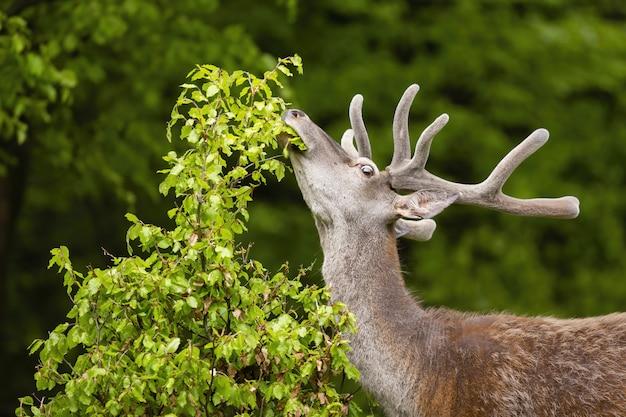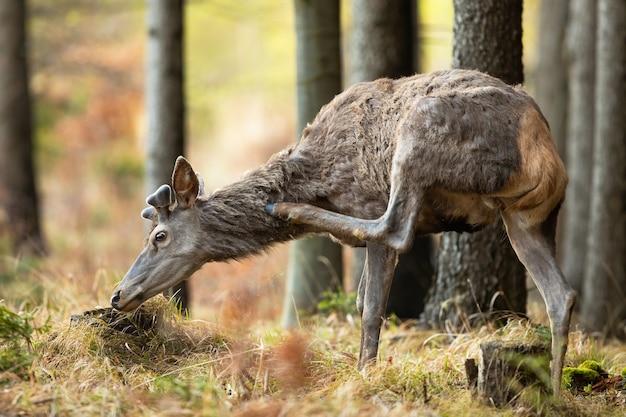Deer hunting requires precision and knowledge of where to aim for a clean and ethical kill. One common question that arises among hunters is whether a neck shot can effectively kill a deer. In this blog post, we will explore the viability of neck shots as a humane hunting method.
We will address various aspects related to neck shots, including their effectiveness, ethical considerations, and alternative shot placements. Additionally, we will discuss the time it takes for a deer to die after being shot and explore the reasons why deer may go to water after being wounded.
Join us as we dive into the world of deer hunting and unravel the mysteries surrounding neck shots and their impact on deer mortality. Gain a deeper understanding of the best shot placement techniques to ensure a successful and ethical hunting experience.
Will a Neck Shot Successfully Take Down a Deer
A neck shot is a common method used by hunters to bring down a deer quickly and efficiently. But does it always guarantee a successful kill? Let’s explore the ins and outs of this technique and find out if it’s as effective as it sounds.
Understanding the Anatomy of a Deer’s Neck
To comprehend the potential impact of a neck shot, it’s crucial to grasp the structure and vulnerabilities of a deer’s neck. The neck is primarily composed of slender and highly-important structures, such as the spinal cord, major blood vessels, and vital airways. A precise shot at the right spot can swiftly incapacitate a deer, leading to a swift and ethical kill.
The Accuracy Factor: Aiming for the Right Spot
Hitting the deer’s neck precisely is paramount for a neck shot to be effective. However, it requires a higher level of accuracy and marksmanship than other targeting areas, such as the heart or lungs. As a hunter, you need to be adept at hitting a smaller target and accounting for the deer’s movements. Practice and experience play a vital role in achieving the necessary precision.
The Instant Paralysis Potential
One of the main advantages of a neck shot is its potential to cause instant paralysis. If the shot successfully severs the spinal cord, a deer’s ability to move and flee will be halted instantly, leading to a much quicker and cleaner kill. This reduces the possibility of a wounded deer running off and suffering needlessly.
Factors Influencing Success
While a well-placed neck shot can swiftly take down a deer, several factors can affect its success rate. The angle of the shot, the distance from the target, the type and caliber of the firearm—all these elements can influence the outcome. It’s essential to consider these factors and ensure optimal shooting conditions to increase your chances of success.
Ethics and Personal Choice
The debate about the ethics of neck shots continues among hunters. Some argue that a well-executed neck shot is a humane and efficient method. On the other hand, critics claim it carries a higher risk of wounding the deer without causing an immediate fatality. As a responsible hunter, it’s important to assess your own shooting skills honestly and choose the method that aligns with your personal values.
In conclusion, a neck shot can be an effective and ethical way to bring down a deer quickly. However, it requires a high level of accuracy and marksmanship. Understanding the anatomy of a deer’s neck and considering the influencing factors are crucial for a successful kill. Ultimately, the decision to opt for a neck shot or not depends on your shooting abilities and personal stance on the matter. Happy hunting!
Will A Neck Shot Kill A Deer: Frequently Asked Questions
Can you shoot a deer that’s lying down
Yes, you can shoot a deer that is lying down. However, it is important to be cautious and consider the angle and location of the shot to ensure a quick and ethical kill. Shooting a deer while it is lying down may require adjustments to your aiming point, as the vital organs may be in a different position than when the deer is standing.
Where to shoot a deer to drop it in its tracks
To drop a deer in its tracks, aim for the deer’s vital organs. The most effective shot placement is in the heart and lung area. This shot placement ensures quick and humane kills, as it disrupts the deer’s respiratory system and causes rapid blood loss, resulting in an expedited drop.
Where should I aim my neck for deer
While neck shots can be lethal, they are not recommended for inexperienced hunters. The neck area is relatively small and carries a higher risk of wounding the deer rather than providing an instant kill. It is crucial to prioritize ethical hunting by aiming at the vital organs to minimize suffering.
How long does it take a deer to die after being shot
The time it takes for a deer to die after being shot can vary depending on several factors, including shot placement, the type of weapon used, and the skill of the hunter. Ideally, a well-placed shot will result in a quick and humane kill, causing the deer to expire within seconds to a few minutes. However, it is essential to wait patiently before approaching the downed deer to ensure it has expired.
Where do you shoot a deer with pictures
When aiming at a deer, it is crucial to target the vital organs for a quick and ethical kill. To get a better understanding of the specific shot placement, refer to the illustrations and diagrams available. These visuals can assist you in identifying the heart and lung area, which is the optimal target for ethical deer hunting.
Where do you aim deer
For an effective and humane kill, aim for the deer’s vital organs, specifically the heart and lungs. By focusing on this area, you are more likely to cause rapid blood loss, disabling the deer quickly. Ensure you have a clear shooting lane and take an accurate shot to maximize the chances of success.
How long after killing a deer is the meat good
After killing a deer, it is crucial to properly field dress and process the meat as soon as possible. In general, if handled correctly, the meat can remain good for up to seven to ten days when refrigerated under optimal conditions. It is important to follow good hygiene practices and promptly cool the meat to ensure its freshness and prevent spoilage.
Will a shoulder shot kill a deer
While a shoulder shot can be lethal, it may not result in an immediate kill. Aiming for the shoulder may damage the deer’s bones, but it is essential to remember that the vital organs are located further back in the deer’s body. For a more effective and humane kill, aim for the heart and lungs, as this increases the chances of a quick expiration.
Why do deer go to water when shot
When injured, deer may instinctively seek water sources. This behavior is thought to help counteract the effects of blood loss and reduce the chance of infection. Additionally, water can help cool the deer’s body, providing relief from stress or pain. Keep in mind that this behavior is not guaranteed, and wounded deer can behave unpredictably.
Are neck shots on deer ethical
Neck shots on deer can be effective when executed correctly, but they require a high level of skill and marksmanship. Given the relatively small target area, neck shots carry a higher risk of wounding rather than providing an instant kill. To prioritize ethical hunting, it is generally recommended to aim for the heart and lung area to minimize suffering.
Where do you shoot a deer from above
When shooting at a deer from an elevated position, it is crucial to adjust your aiming point to compensate for the angle. Aim for the vital organs, specifically the heart and lungs, but take into account how the shot trajectory may differ from shooting at ground level. Understanding the anatomy of a deer and practicing shot placement will help increase your chances of a successful hunt.
What does it mean when a deer flicks its tail after being shot
A deer flicking its tail after being shot is a common reaction known as a “tail flag.” This behavior typically indicates high stress, pain, or a warning to other deer in the area. It is important to remain patient and give the deer ample time to expire before approaching, as a wounded deer can still pose a potential danger.
Is shooting a deer in the head illegal
In most jurisdictions, shooting a deer in the head is considered illegal and unethical. The head is a small target, and the risk of wounding rather than killing the deer is high. Additionally, a headshot may damage the deer’s antlers, decreasing their trophy value. It is best to aim for the heart and lungs area to ensure a quick and humane kill.
Can a deer get shot and not bleed
It is possible for a deer to get shot and not exhibit external bleeding. The absence of visible blood does not necessarily mean the deer was not hit. Depending on the shot placement and the specific circumstances, internal bleeding may occur without immediately showing external signs. Tracking the deer carefully and looking for other indications of a hit are crucial in such situations.
Is a neck shot on a deer good with a bow
While it is technically possible to take a neck shot on a deer with a bow, it is generally not recommended. The neck area is small and carries a higher risk of wounding the deer rather than providing a clean kill. To ensure an ethical hunt and minimize suffering, archery hunters are advised to aim for the heart and lungs, allowing for a higher chance of success.
Where do you shoot a deer at an angle
When shooting a deer at an angle, adjust your shot to target the vital organs. Visualize the trajectory and aim for the area just behind the shoulder, angling inward towards the center of the deer’s body. This shot placement ensures the bullet or arrow travels through the heart and lungs, maximizing the chances of a quick, humane kill.
Can a deer survive a single lung shot
Deer can survive a single lung shot, but it will likely suffer significantly and may expire later from its injuries. If you suspect you made a single lung shot, it is vital to exercise patience, give the deer ample time before tracking, and follow the blood trail carefully. It is crucial to ensure ethical hunting practices, prioritizing quick and humane kills through accurate shot placement.
What are the best times to go deer hunting
The best times to go deer hunting are during the early morning hours and late afternoon into the evening. Deer are most active during these periods, known as the “golden hour.” This is when they are searching for food or moving to different areas. Additionally, focus on hunting during the rut season, usually in late October to early November, when deer activity is at its peak.

